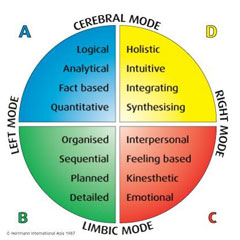
In school, an educator will see that students will be different; they will have different cultures, different languages, different ethnic backgrounds, and different learning and thinking styles. Educators will need to understand these differences and develop a curriculum that will allow all students to learn no matter what their culture, language, ethnic background, or learning and thinking styles.
Epistemological diversity is the study of the different thinking styles. People in general think differently from one another. For example, I like to look at a novel and be able to discover different meanings of that text. I like to know that there may not be a right or wrong answer. Another person on the other hand may only want to know the facts. They want only one answer or idea to be right. Educators will need to develop a differentiated curriculum that will accommodate different thinking styles.
Thinking and learning happens all the time. Our schools system if set up for students to learn different subjects at a certain time of day and then take one test at the end of the year to assess their learning. This style allows many students to fail because they cannot communicate their knowledge in the way that best fits them. Also, this style doesn’t allow for merging the different disciplines. For example, an English language arts (ELA) class and a social studies class would often complement each other. This would also allow for different learning styles to emerge. I always did well in an ELA class when the literature was put into the context of history. Also a person in a math class may benefit from writing out in words the procedure to a problem. Allowing different forms of thinking and assessing students in multiple ways will give more success to the students.

Many different cultures and ethnicities have been either labeled or permitted to fail because of the epistemological differences that they may have. One group in particular is the Native Americans. Native Americans “were assumed to lack verbal, cognitive, even motor skills necessary to succeed in schools” (16). Native Americans were often assumed that they would fail in school; however, schools fail Native Americans because they do not allow diversity in the way which people think.
There are many different characteristics for indigenous education. According to Lomawaima and McCarty, to understand Native peoples, we have to “understand their theories of the origins of life, their ethics to maintain life, and their methods of constructing the past and envisioning the future” (23). Indigenous education will incorporate observation (of the surroundings), organization (of the knowledge of the past), explanation (of what we see and who we are), coping (with circumstances) and planning (for the future). (23). Indigenous education would also include multiple levels of understanding. For example, Native oral traditions at one level are “simple fairy tale [that] enthrall children” but at other levels these oral traditions “direct behavior and stories encode the past as well as the present” (24). Indigenous education often educates for strength. This is to meet the “basic needs of society and the individual, which included leadership, protections, sustenance, learning, and physical well-being” (28). There are many other characteristics of indigenous education such as “education according to gender” and “education according to age.”
There are many differences between indigenous education and US schooling. US schooling most often takes form of “formal” education. Formal education usually occurs in a building with students grouped together according to age during certain hours of the day, Indigenous education if often considered informal because it occurs “out of school” (not in a building). However, indigenous education now occurs “in” and “out” of school.
Mainstream schooling should incorporate many of the characteristics of indigenous education. By doing this, mainstream schools will allow epistemological diversity. Incorporating learning that happens outside of school will merge home life with school life and will also incorporate many different thinking abilities.
No comments:
Post a Comment